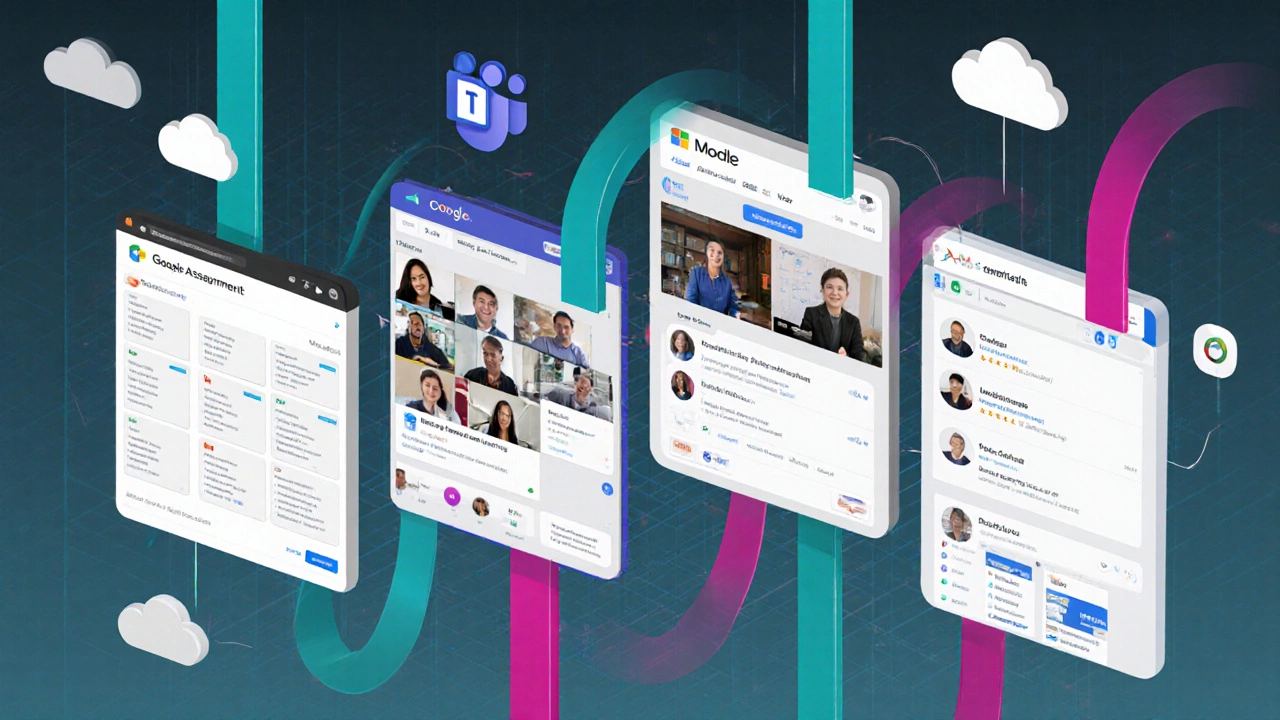Oct
14

- by Dhruv Ainsley
- 0 Comments
Teaching Tool Selector
Find Your Perfect Free Teaching Tool
Answer a few questions to get personalized recommendations for free apps that match your classroom needs.
Your Class Size
Your Primary Need
Special Requirements
Tech Comfort Level
Finding a reliable, cost‑free app that can handle live lessons, assignments, and student interaction feels like hunting for a unicorn. Yet several platforms have stepped up, offering robust feature sets without charging a dime. Below you’ll see which ones truly shine for teachers who need a solid virtual classroom without breaking the budget.
Key Takeaways
- Google Classroom, Microsoft Teams, and Zoom’s free plan lead the pack for live video and assignment management.
- Open‑source Moodle and Canvas provide deep customization if you can host them yourself.
- All listed apps work on Windows, macOS, Android, and iOS, but bandwidth limits vary.
- Consider class size, integration needs, and data privacy when picking the right tool.
How We Ranked the Apps
We measured each platform against five practical criteria:
- Live video capacity - maximum participants, meeting length, and screen‑sharing quality.
- Assignment workflow - ease of creating, collecting, and grading work.
- Collaboration tools - chat, breakout rooms, polls, and whiteboard features.
- Device compatibility - native apps and browser performance across desktops and mobiles.
- Data privacy & security - compliance with GDPR, FERPA, and Australian privacy law.
Each app earned a score from 1 (weak) to 5 (strong) for every category. The totals drive the ordering in the comparison table.

Free Online Teaching Apps Reviewed
Google Classroom is a web‑and‑mobile platform that integrates tightly with Google Workspace, letting teachers create classes, distribute assignments, and hold video sessions via Google Meet. The free tier supports unlimited classes and up to 100 participants per Meet session, with recordings saved to Drive. Its strength lies in the seamless hand‑off between Docs, Slides, and Sheets for collaborative work.
Microsoft Teams offers a robust free version that includes video meetings, file storage, and built‑in Office online apps. Teams caps meetings at 60 minutes with up to 100 participants, but you can schedule recurring sessions for a whole semester. The chat and breakout‑room features make it easy to run small‑group activities.
Zoom provides a popular free plan that allows 40‑minute meetings for groups larger than two, supporting up to 100 participants. For teachers, the 40‑minute limit works well for short lessons or breakout‑room activities. Zoom’s virtual whiteboard and poll tools are intuitive, and its breakout‑room management is among the best.
Cisco Webex delivers a free tier with 50‑minute meetings for up to 100 attendees, along with screen sharing and digital whiteboard capabilities. Webex stands out for its strong security settings and automatic transcription, which can help students who miss a class.
Moodle is an open‑source learning management system that you can host yourself at no cost. While the platform requires a bit of technical setup, it offers unlimited courses, detailed grading rubrics, and a massive plugin ecosystem for quizzes, forums, and multimedia lessons.
Edmodo acts as a social‑learning hub where teachers post assignments, polls, and discussion threads within a secure environment. The free version caps class size at 200 students and does not include live video, so it pairs well with a separate video tool.
Nearpod offers a free tier that lets teachers create interactive lessons with embedded quizzes, polls, and AR experiences. Nearpod’s live‑lesson mode works with any video conferencing app, turning a standard Zoom call into a highly engaging session.
Canvas provides a free-for‑teachers account that includes course creation, grading, and basic communication tools. Canvas’s intuitive design and robust analytics make it a solid choice for educators comfortable with a slightly more structured LMS.
Side‑by‑Side Comparison
| App | Live Video Limits | Assignment Tools | Collaboration Features | Pros | Cons |
|---|---|---|---|---|---|
| Google Classroom | 100 participants, 24‑hr Meet sessions | Docs/Slides integration, auto‑grade quizzes | Chat, Breakouts, Whiteboard | Deep Google ecosystem, unlimited classes | Requires Google account, limited customization |
| Microsoft Teams | 100 participants, 60‑min meetings | Office online, assignment tracker | Chat, Breakouts, Polls, Files | Strong Office integration, robust admin controls | Interface can feel cluttered for beginners |
| Zoom | 100 participants, 40‑min limit | Basic assignment links via chat | Whiteboard, Polls, Breakouts | Widely adopted, easy UI | Time cap may interrupt longer lessons |
| Cisco Webex | 100 participants, 50‑min limit | Integrates with file storage | Whiteboard, Auto‑transcript | Excellent security, built‑in captions | Free plan lacks some advanced breakout controls |
| Moodle | Self‑hosted - depends on server | Full LMS: quizzes, grading, plugins | Forums, Groups, Wiki | Unlimited customization, no per‑user fees | Requires technical setup and maintenance |
| Edmodo | No native video | Assignments, quizzes, polls | Discussion boards, messaging | Simple social feel, easy onboarding | Missing live‑classroom component |
| Nearpod | Works with any video tool | Interactive slides, embedded quizzes | Live polls, AR, VR activities | Highly engaging multimedia | Free tier limits to 15 participants per session |
| Canvas | Integrates with external video (Zoom, Teams) | Assignments, rubrics, speedgrader | Discussion, Groups, Conferences | Clean UI, strong analytics | Free account caps storage at 1 GB |

Choosing the Right Tool for Your Classroom
If you teach small groups (under 30 students) and need quick video calls, Zoom or Google Meet through Classroom usually cover everything. For larger cohorts, Teams and Webex give you longer meeting windows and stronger admin controls.
When you want a full‑featured LMS without paying, Moodle shines-but be ready to host it on a cloud server or your institution’s infrastructure. Canvas offers a middle ground: a ready‑to‑use LMS with a generous free plan for teachers, though storage caps may require external drives for media‑heavy courses.
For teachers who rely heavily on interactive content, Nearpod adds a layer of engagement that turns a plain video call into a quiz‑driven lesson. Pair it with any of the video apps above for the smoothest experience.
Privacy and Compliance Tips
Australian educators must obey the Privacy Act 1988 and, where applicable, the Education (International Relations) Act. All apps listed claim GDPR compliance, but you should verify whether data is stored on servers outside Australia. Teams and Canvas let you choose regional data centers; Google Classroom stores data in Australian regions when you enable that setting.
Always require students to use school‑managed accounts rather than personal emails. This not only boosts security but also makes it easier to pull audit logs if your school needs to investigate a breach.
Getting Started in 5 Easy Steps
- Pick your core video platform (e.g., Google Meet, Teams, Zoom).
- Create a free teacher account and verify your school email.
- Set up a class or course container, then invite students via a shareable link.
- Upload or link your first assignment using the built‑in assignment tool.
- Run a short test meeting to check audio, video, and screen‑share quality before the first real lesson.
Follow these steps, and you’ll be ready to launch a fully functional online classroom without spending a cent.
Frequently Asked Questions
Can I use these free apps for an entire semester?
Yes. Most platforms-Google Classroom, Teams, Moodle, and Canvas-allow unlimited courses and storage for the free tier. Only video‑meeting time limits (Zoom’s 40minutes, Teams’ 60minutes) might require splitting longer sessions into multiple calls.
Do these tools support offline access for students?
Google Classroom and Canvas let students view downloaded assignments offline, while Moodle’s mobile app caches resources. Video apps need internet, but you can record sessions for later streaming.
Is there a limit on the number of students I can add?
Most free plans cap live‑video participants at 100. For pure LMS usage, Moodle and Canvas have no hard student‑count limits; the only constraint is server capacity for self‑hosted Moodle.
How secure are the free versions?
All listed platforms meet industry‑standard encryption (TLS1.2+). Teams and Webex offer the most granular admin controls, while Zoom’s free tier has had past security concerns but now includes waiting rooms and meeting passwords by default.
Can I integrate these apps with my school’s existing SIS?
Teams, Canvas, and Moodle provide native integrations with popular Student Information Systems (PowerSchool, Skyward, etc.). Google Classroom offers a data‑export API that many SIS vendors can pull from.
Whether you need a lightweight video call tool, a full‑blown LMS, or a mix of interactive content, the free apps above give you a solid foundation. Pick the one that matches your class size, tech comfort, and privacy requirements, and you’ll be set for a successful online teaching experience.





